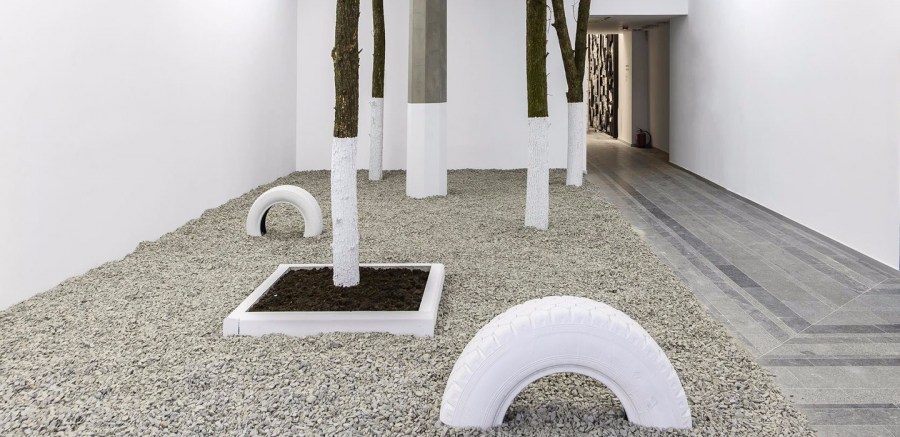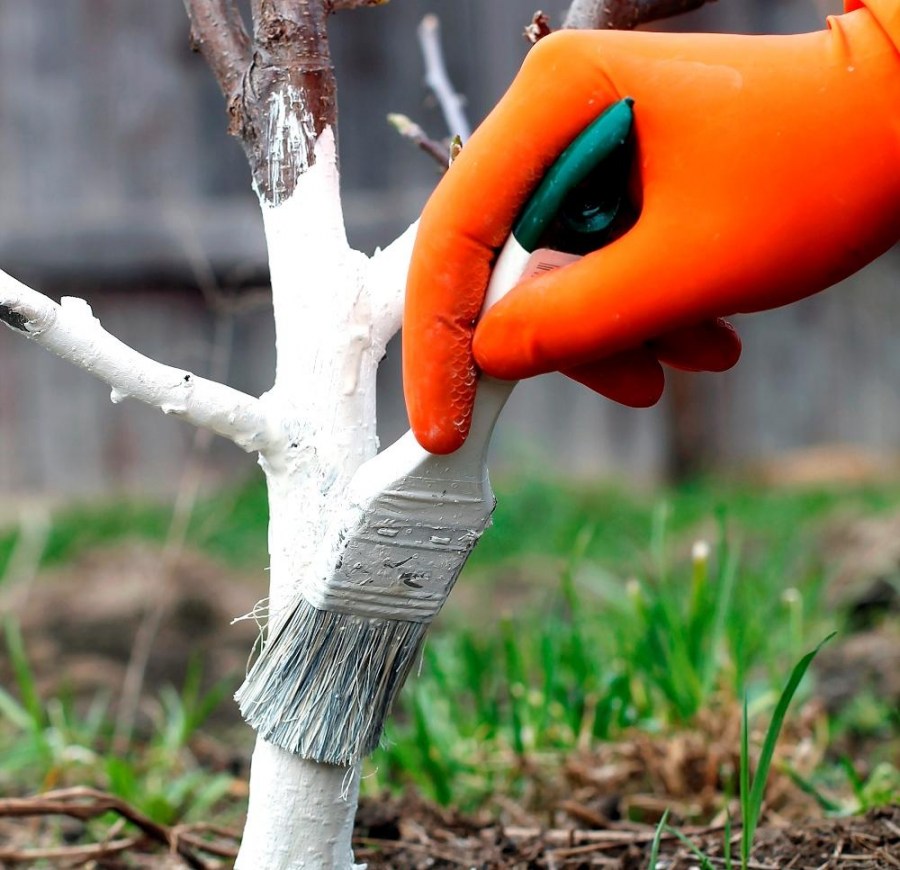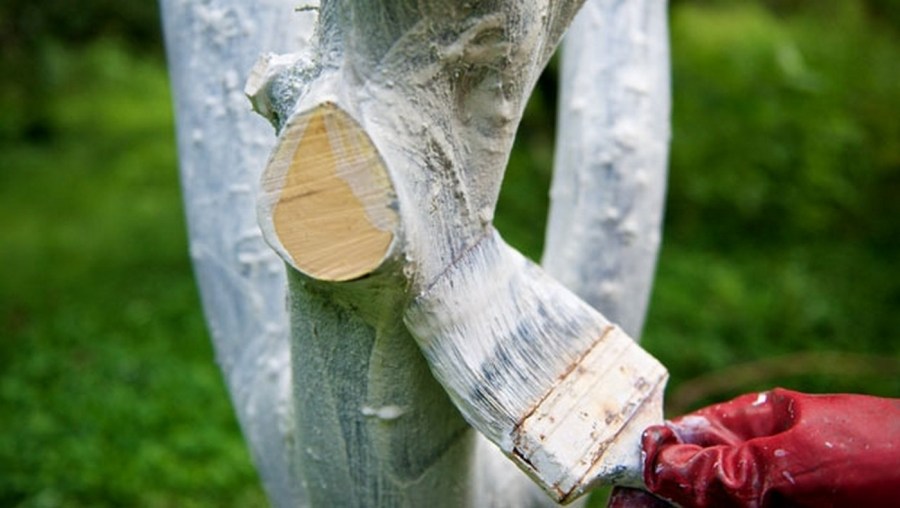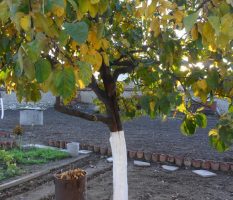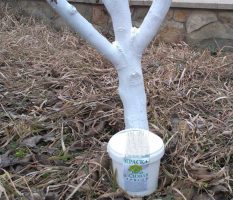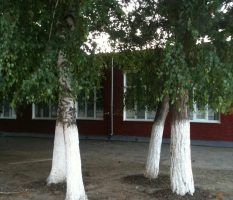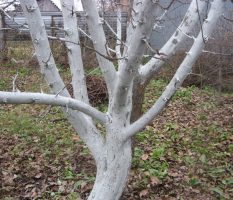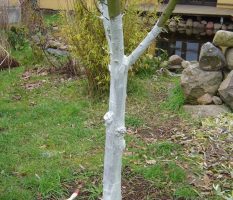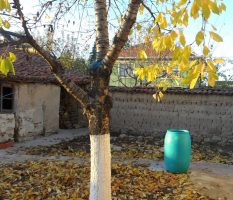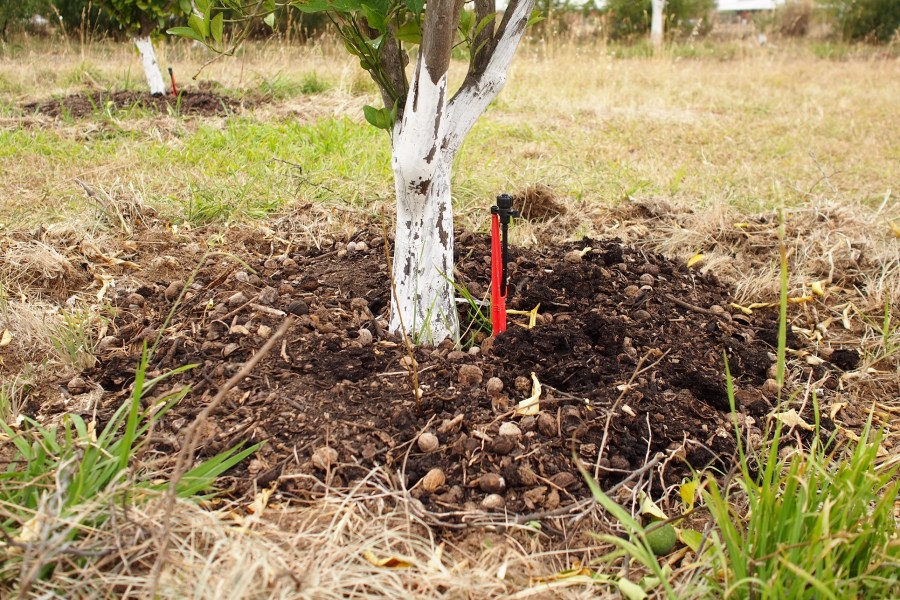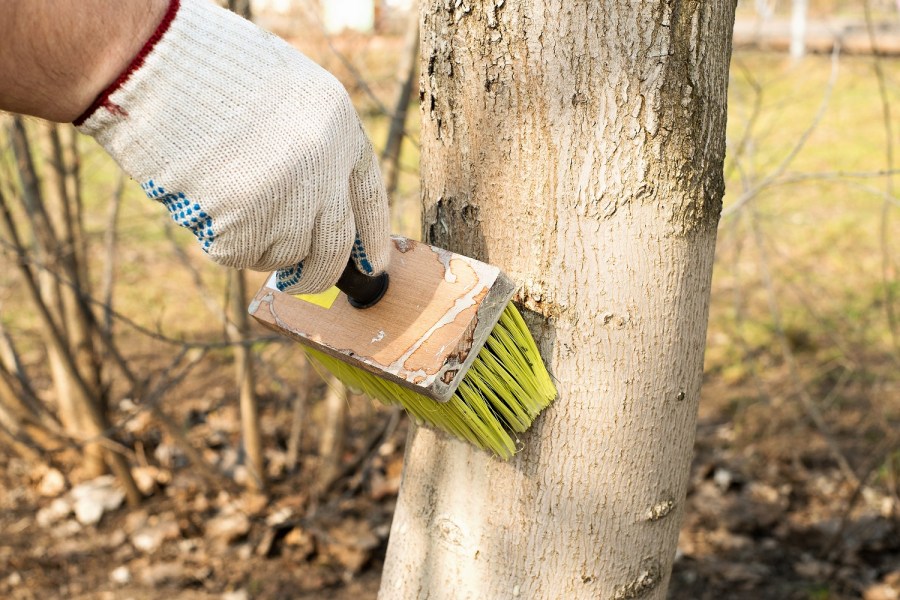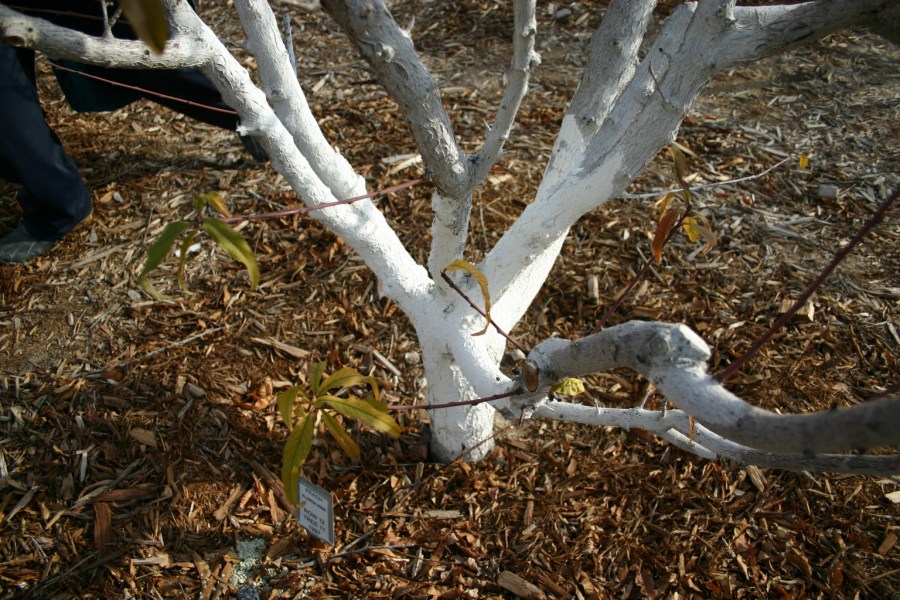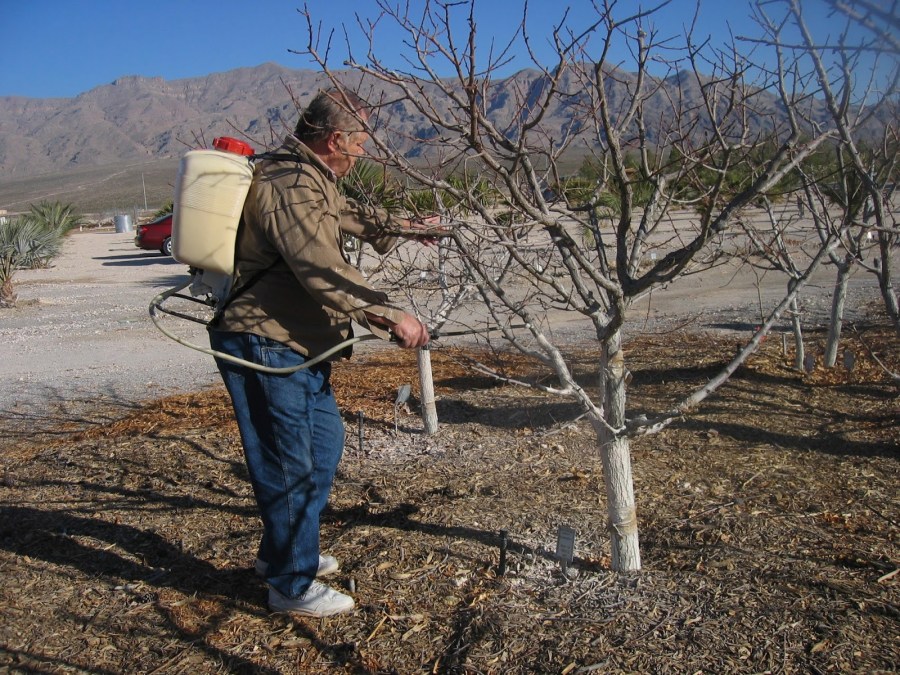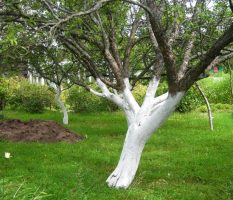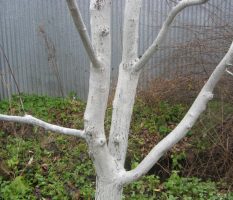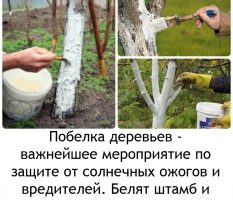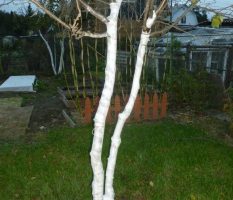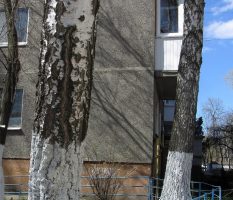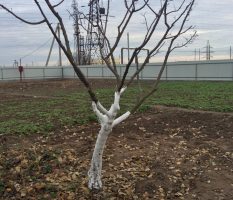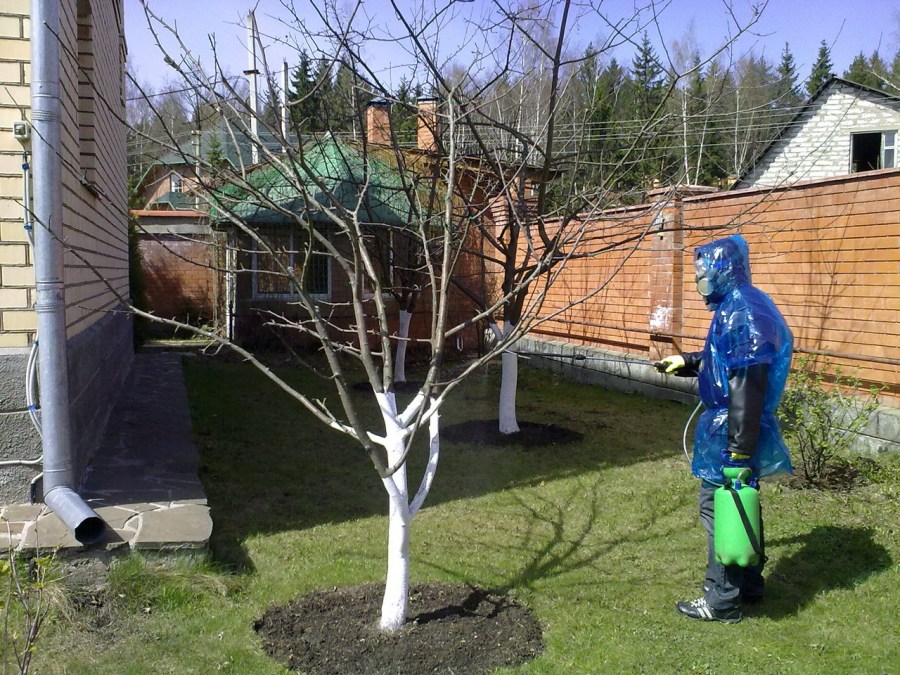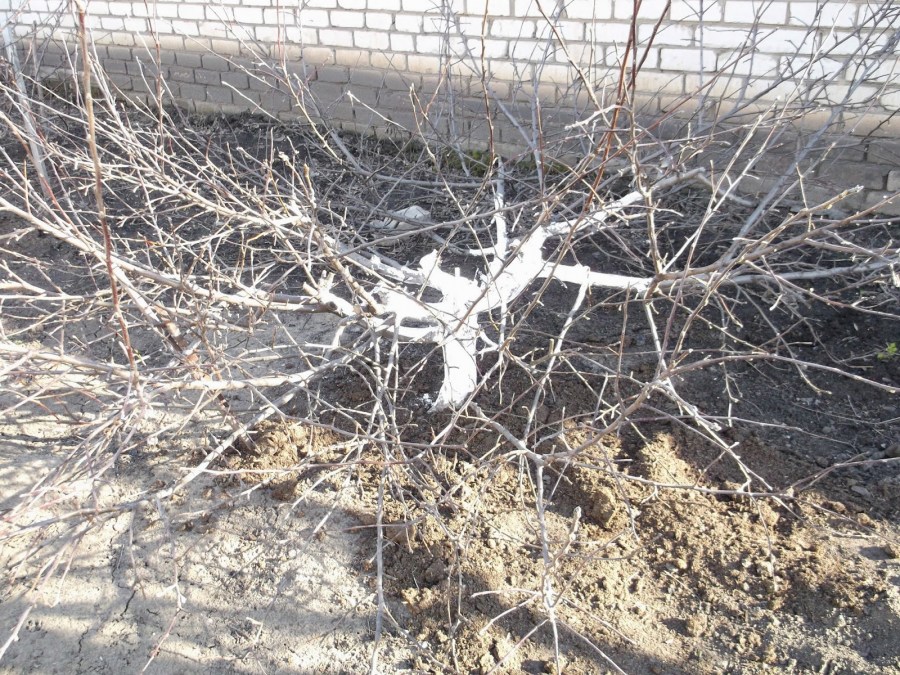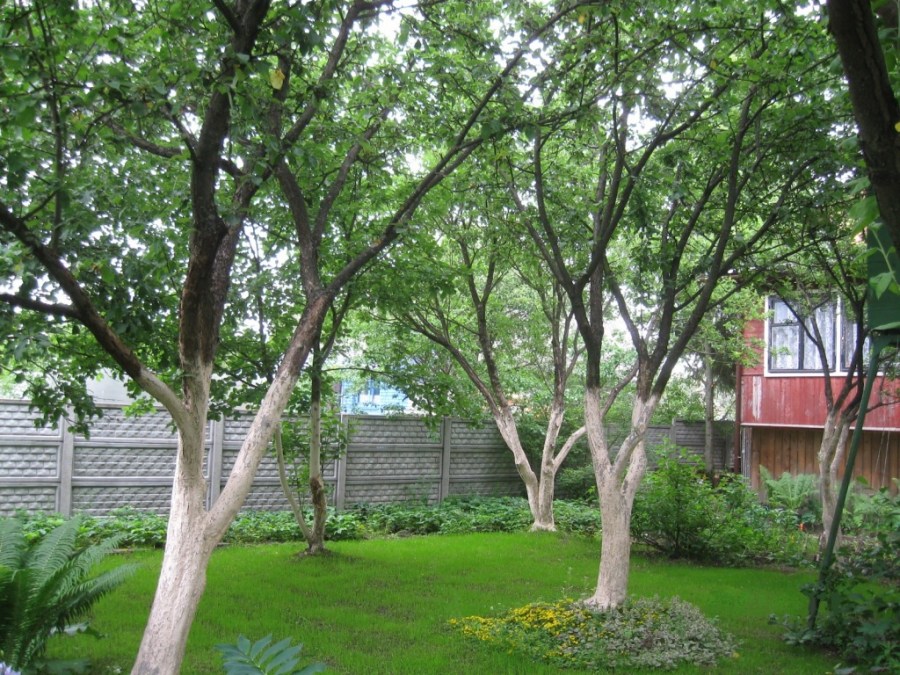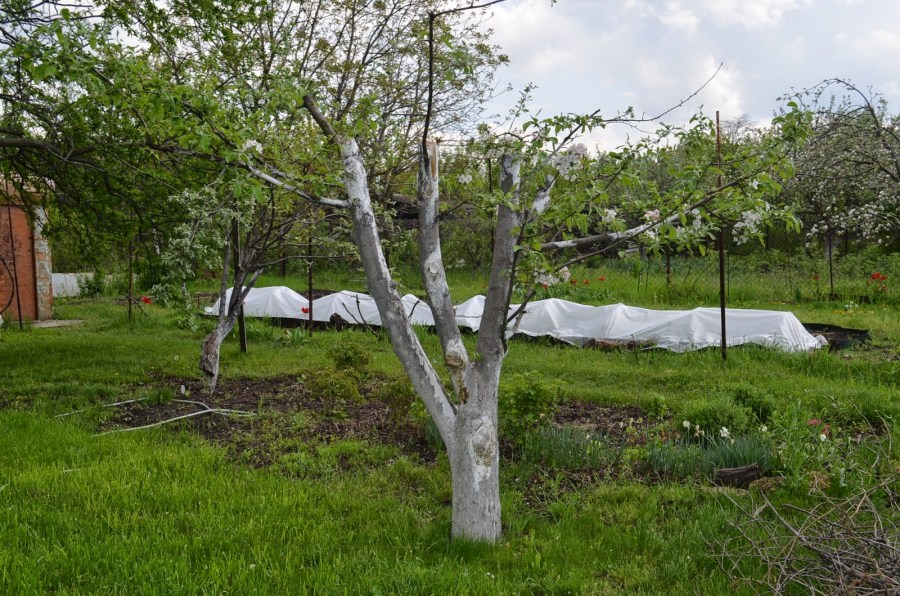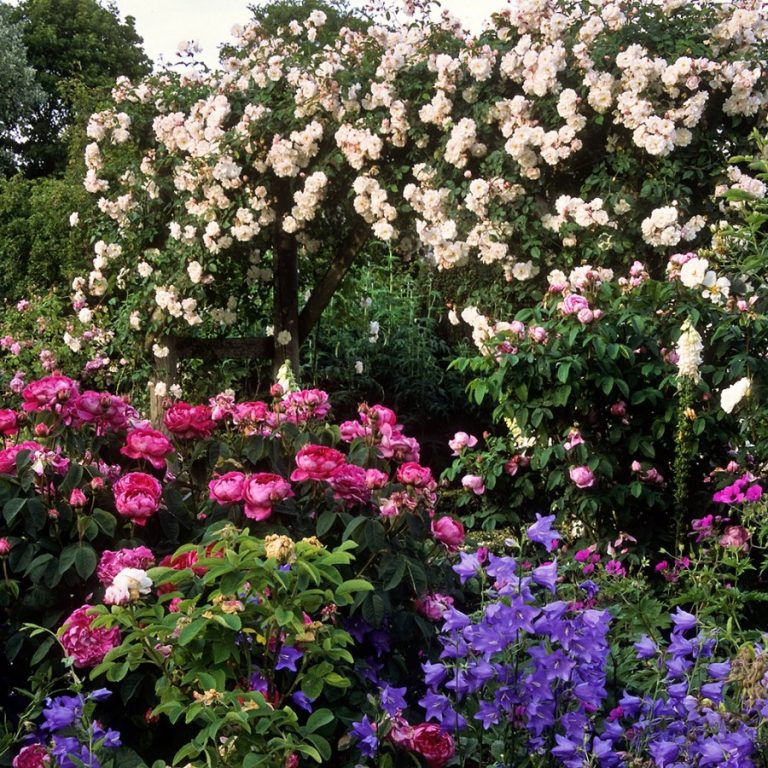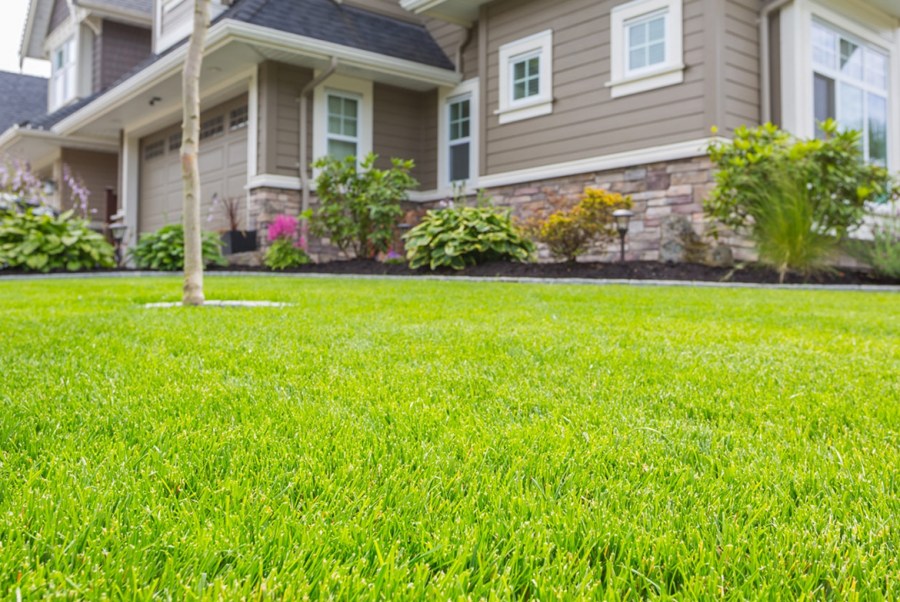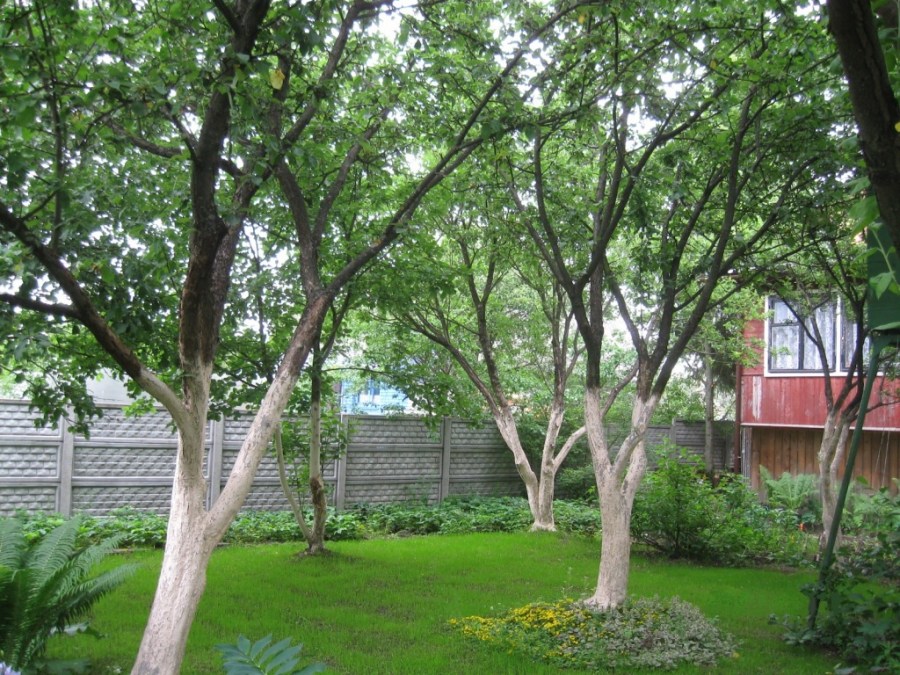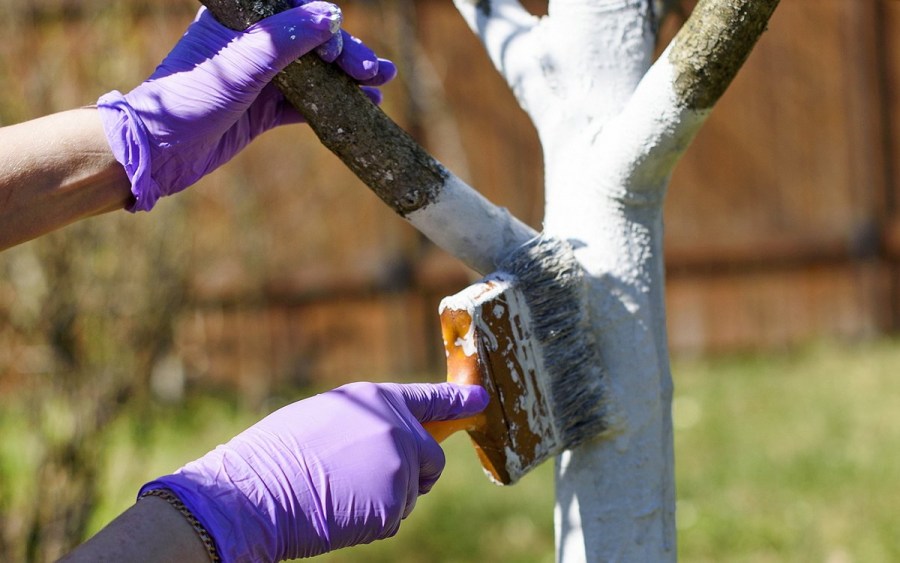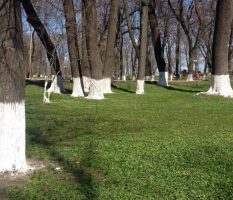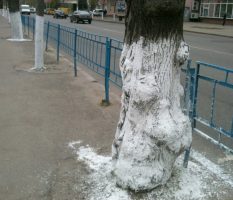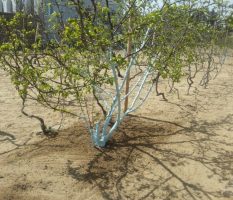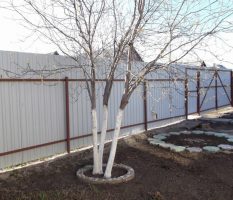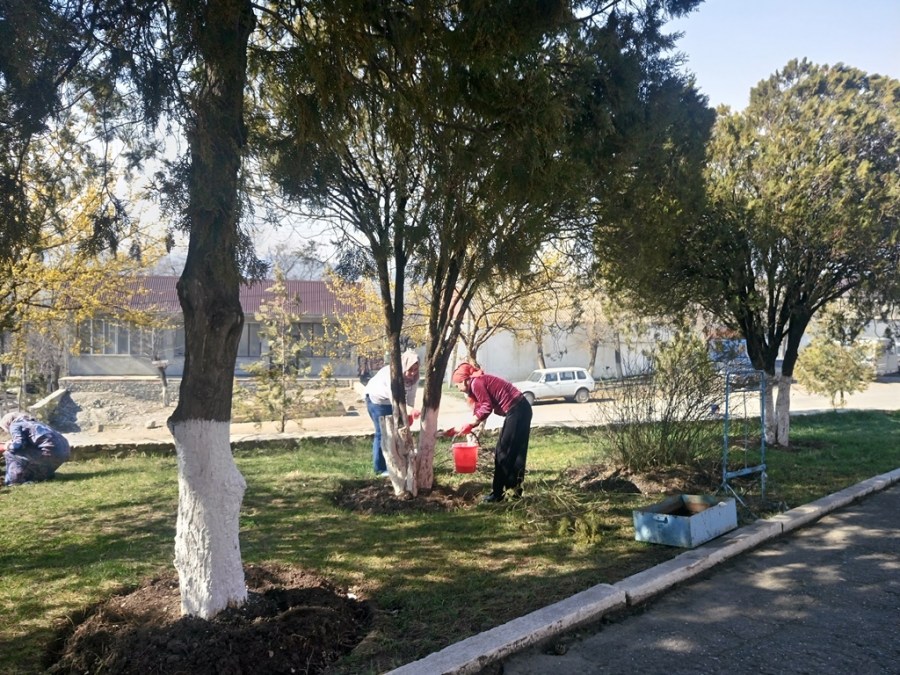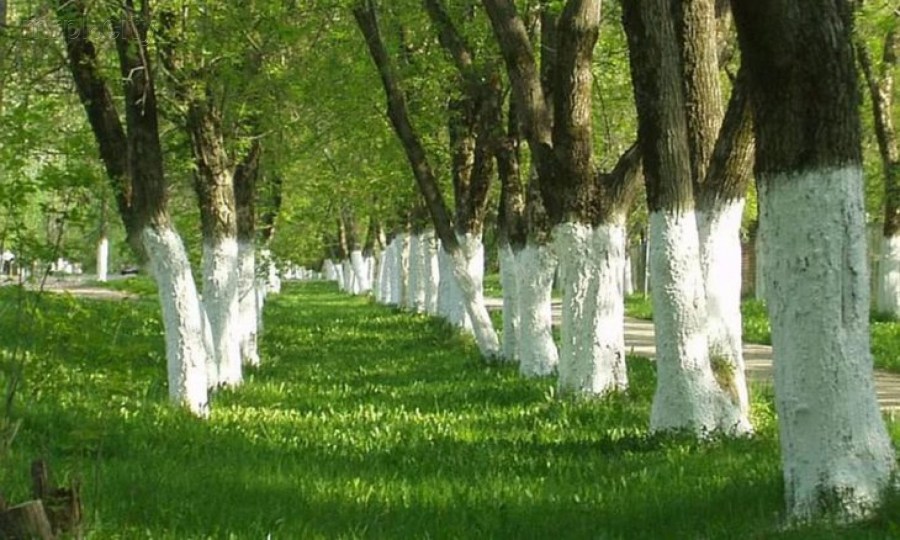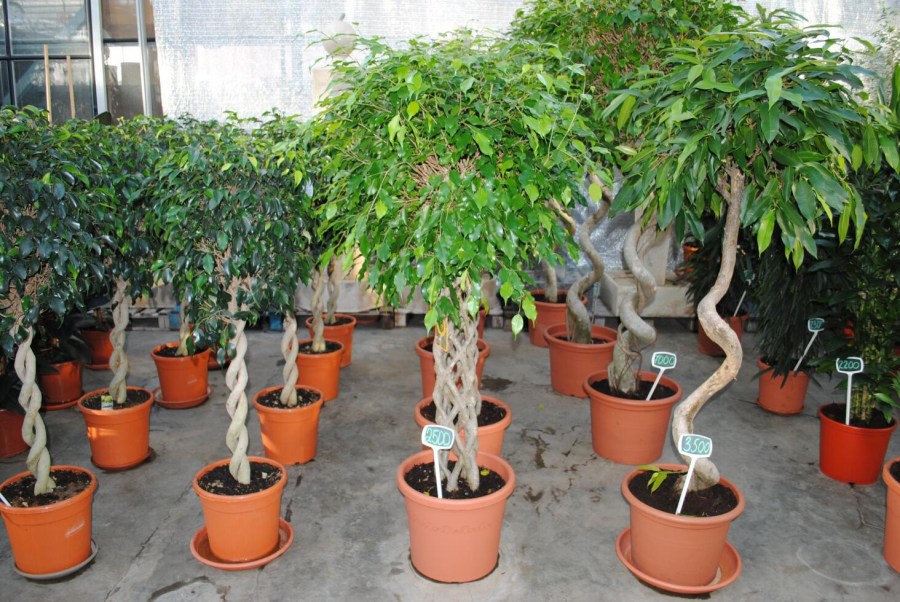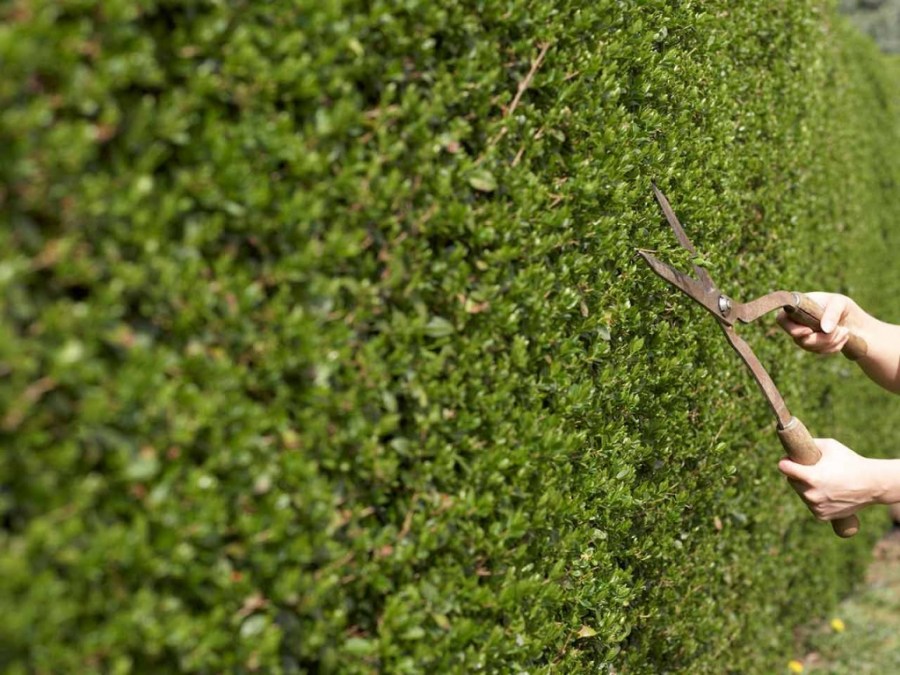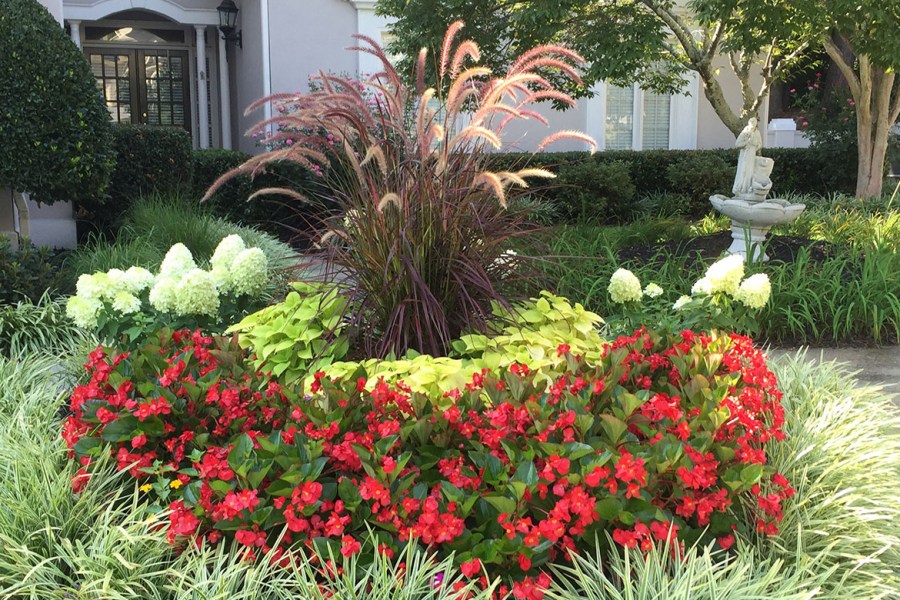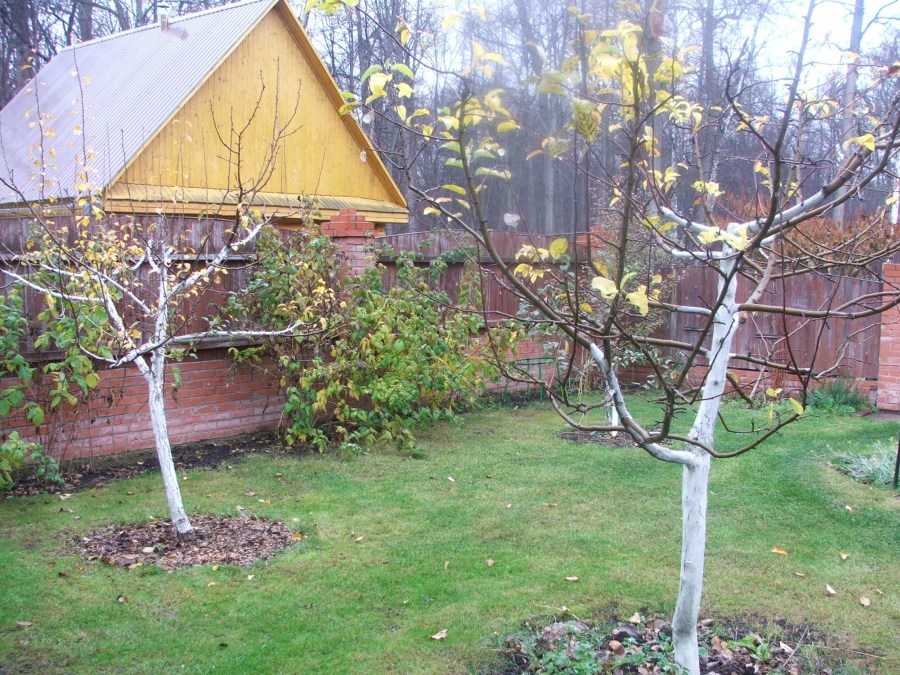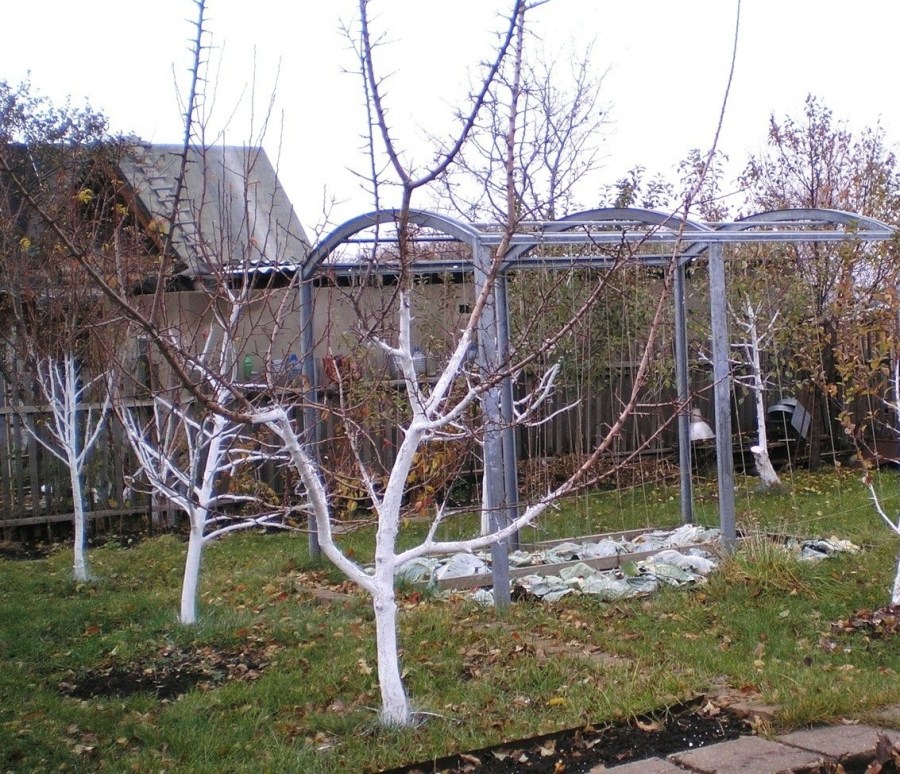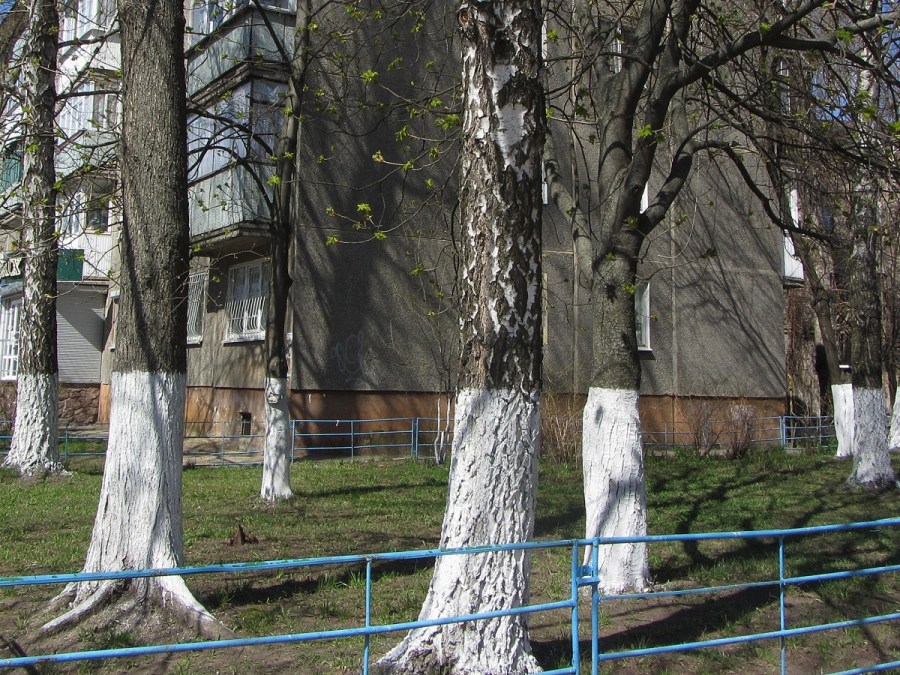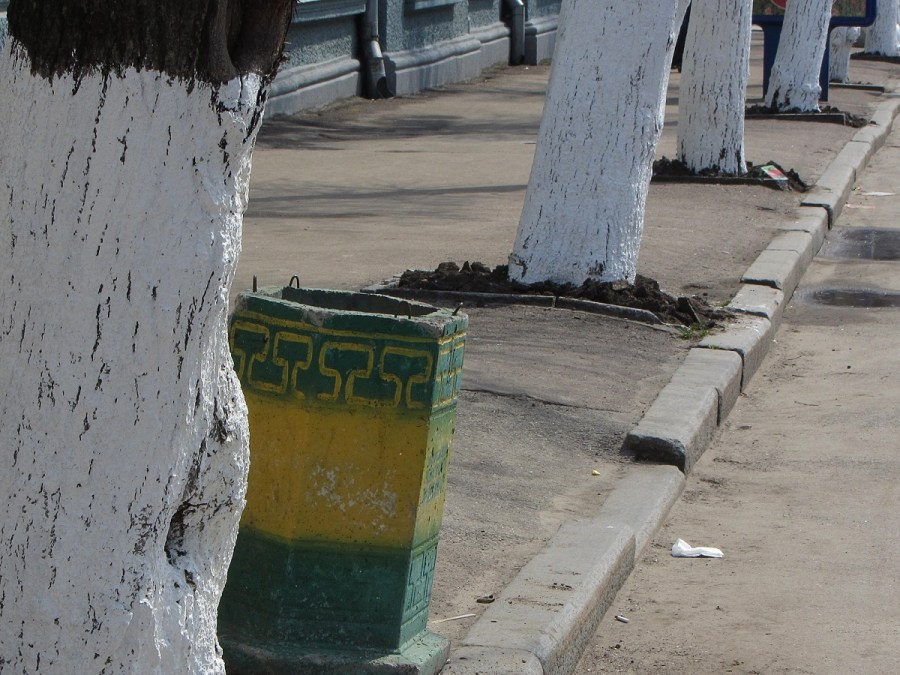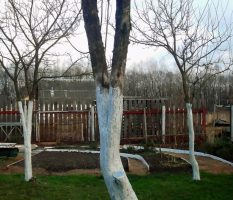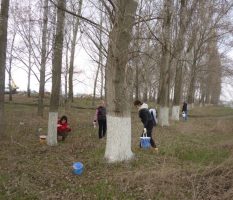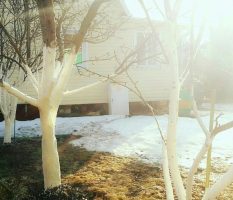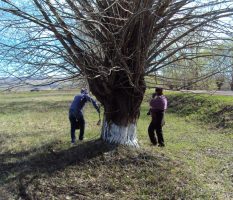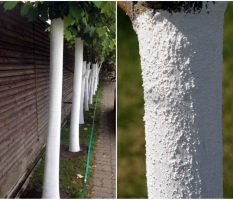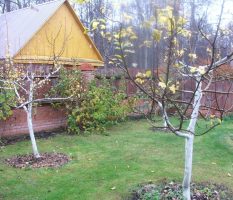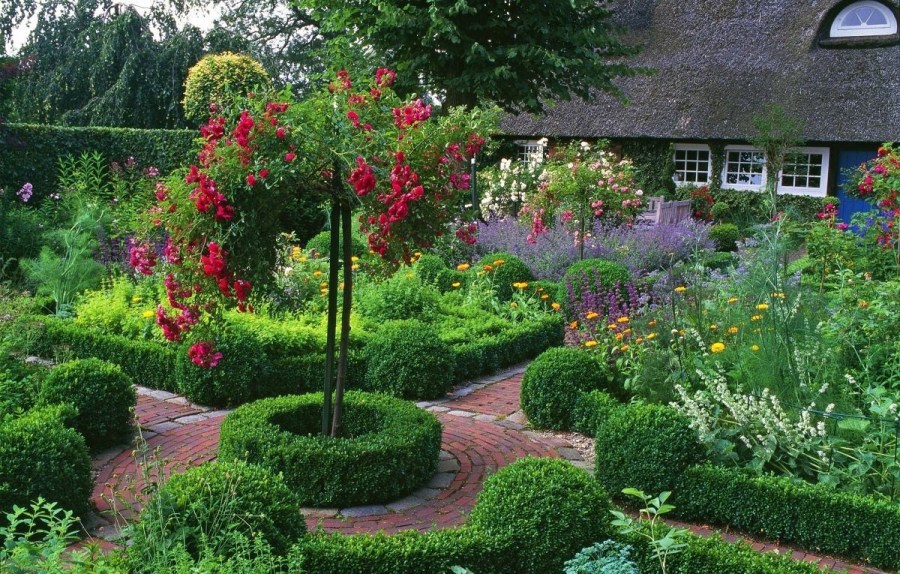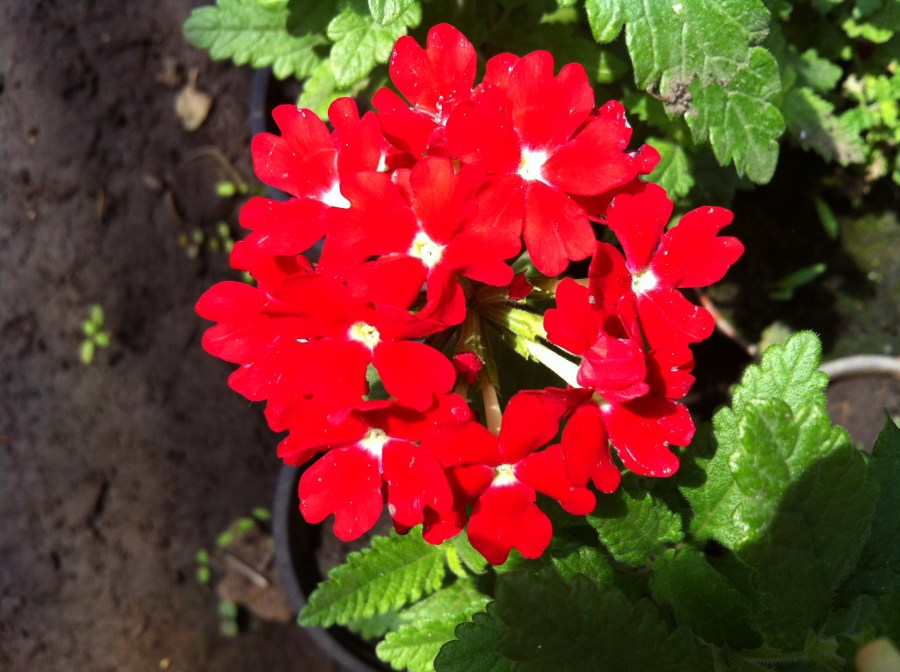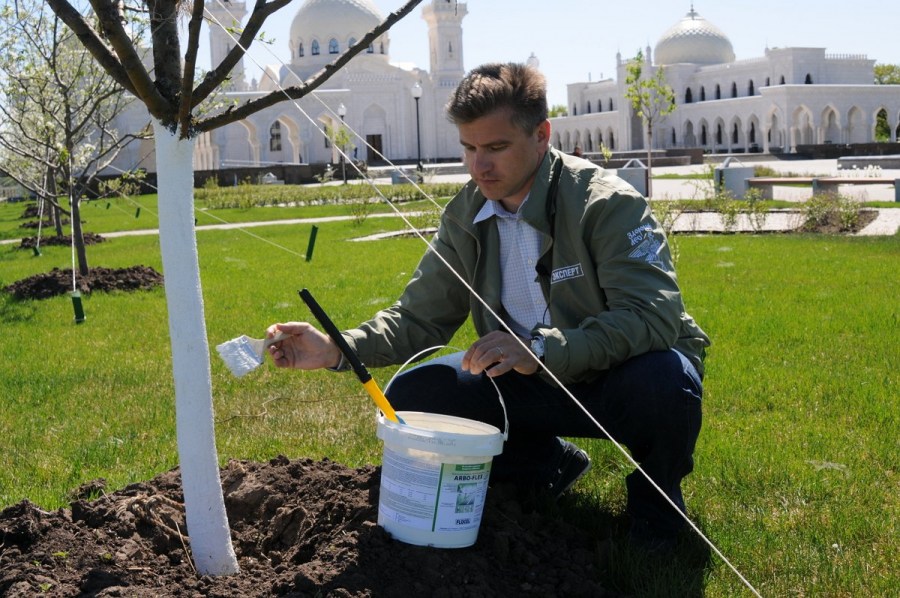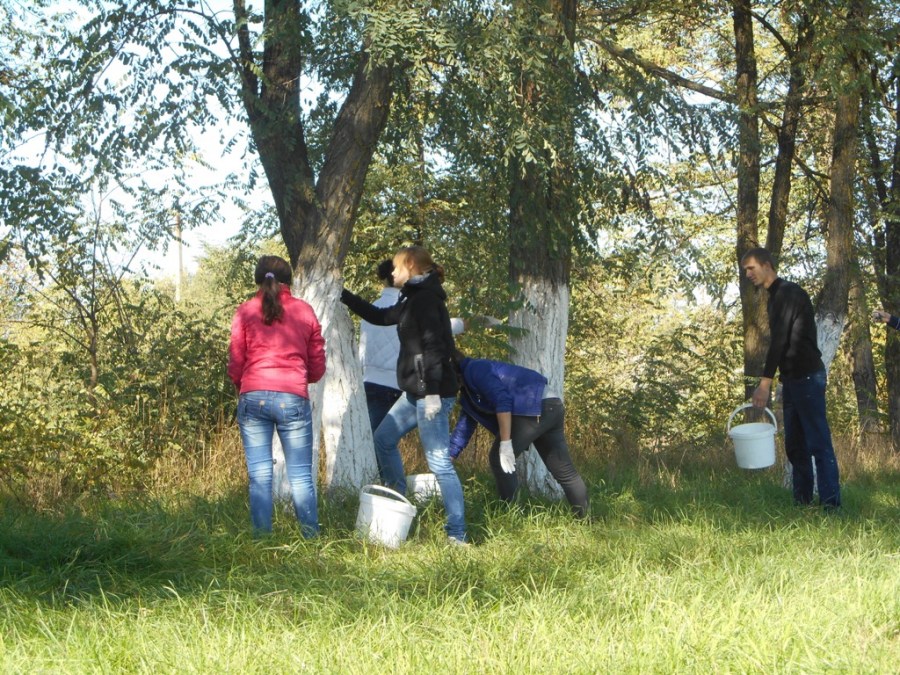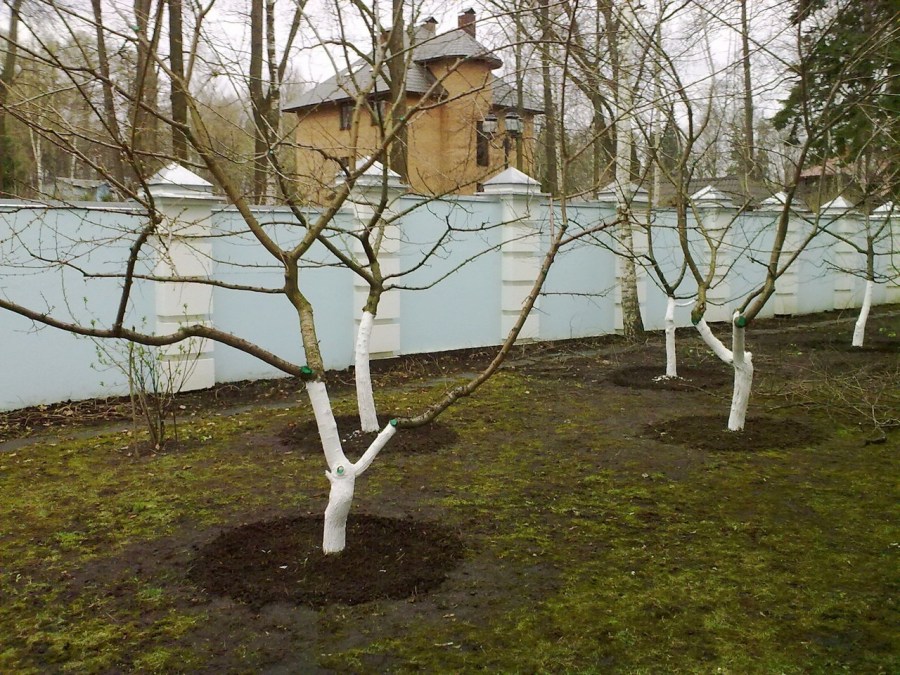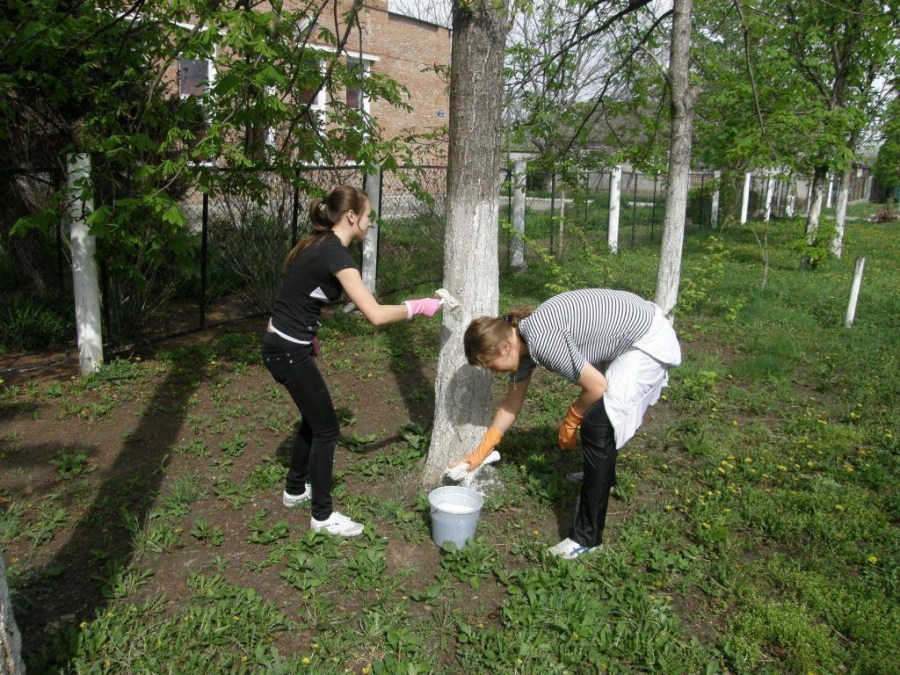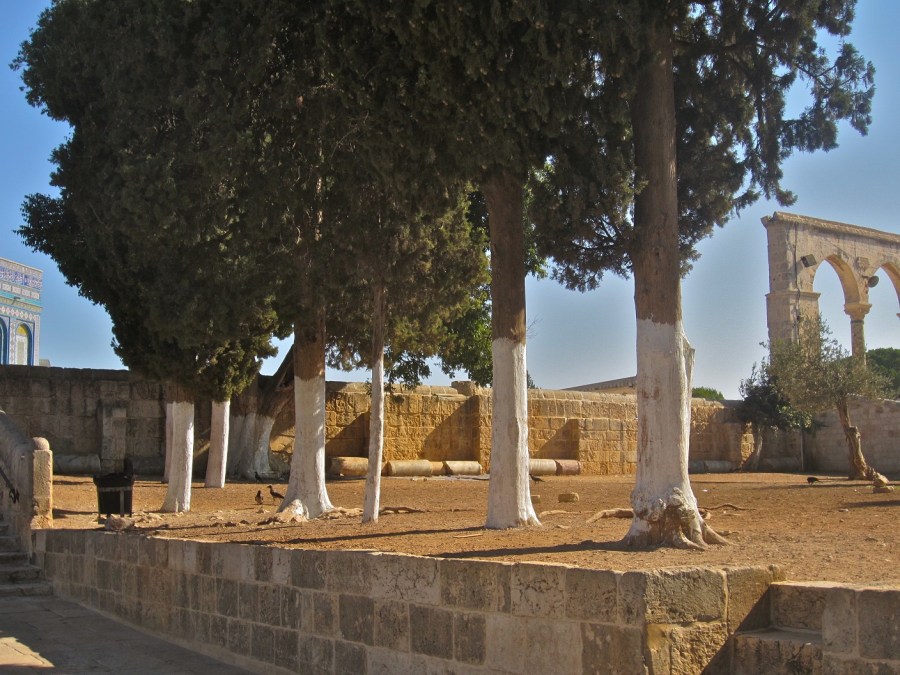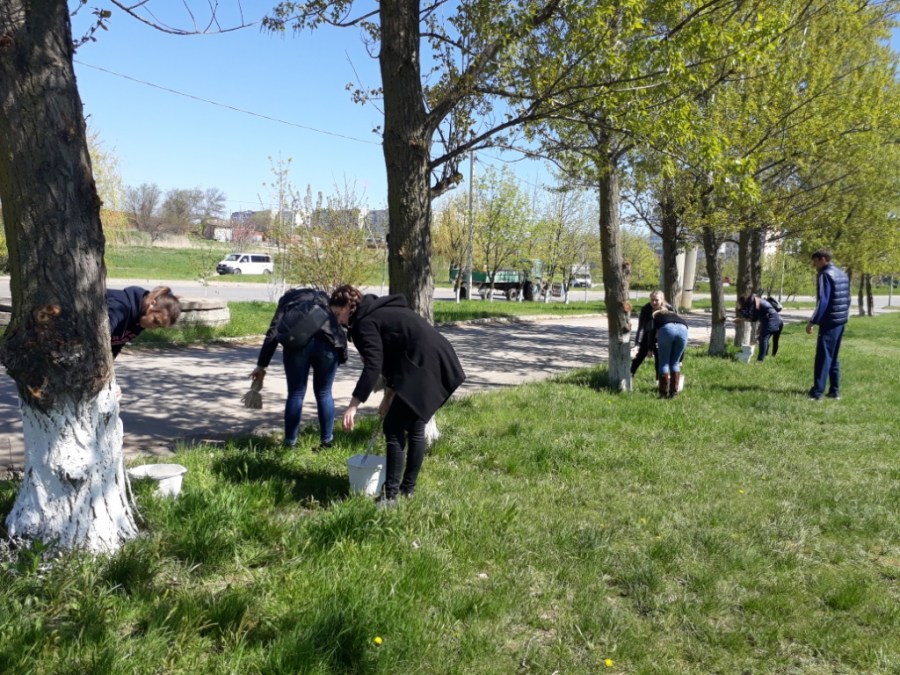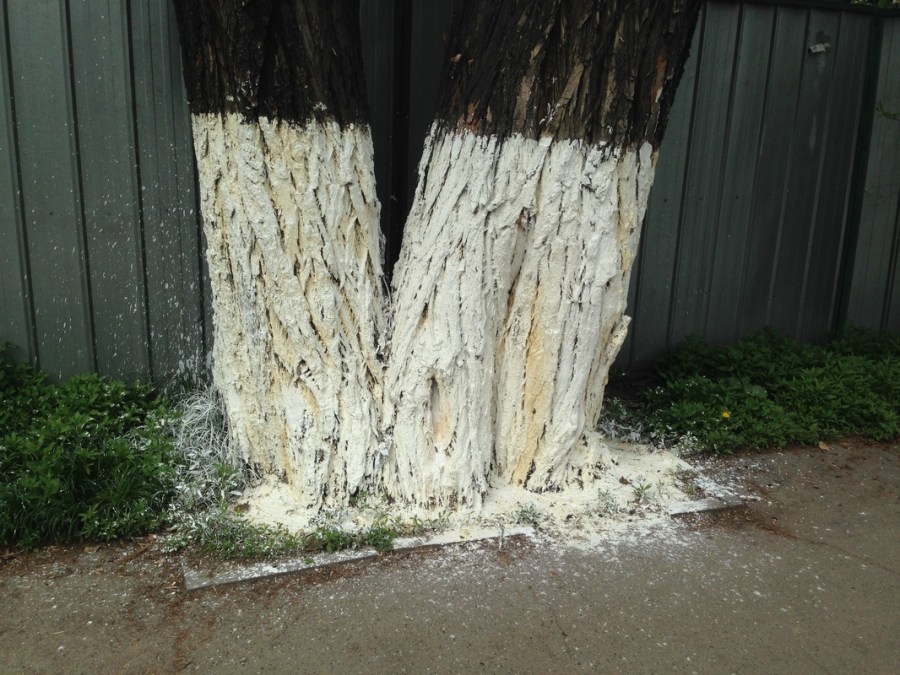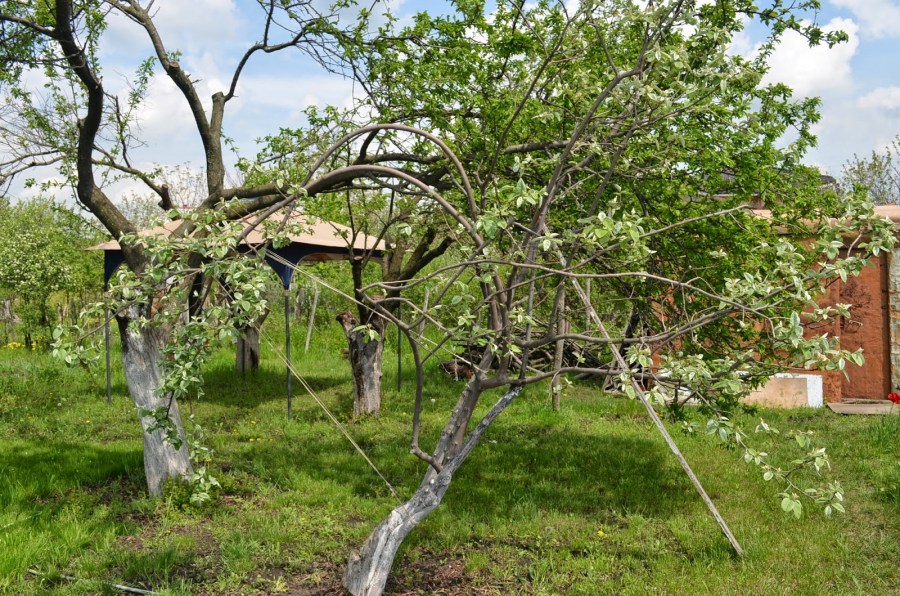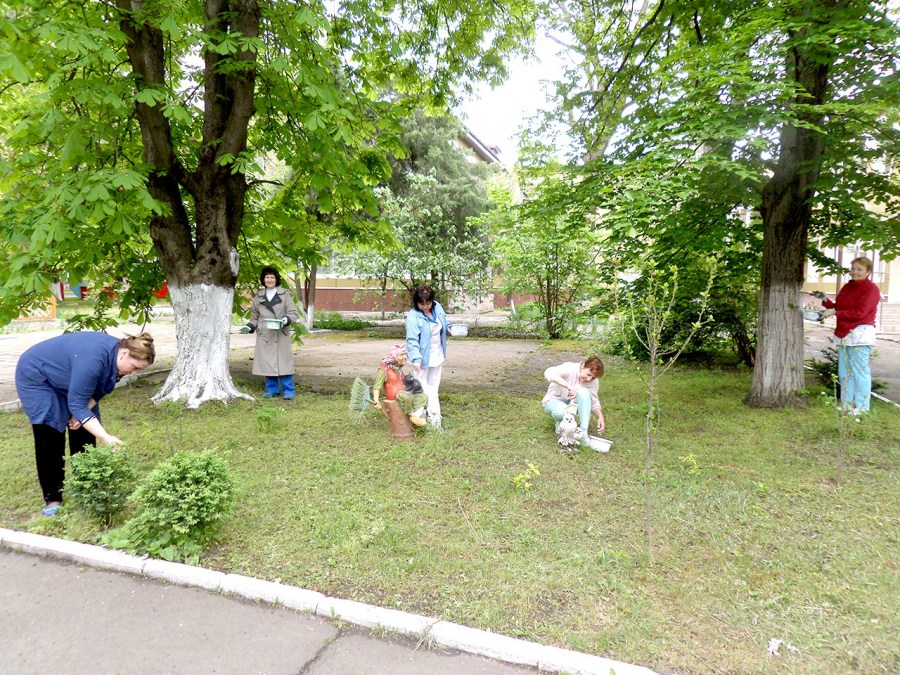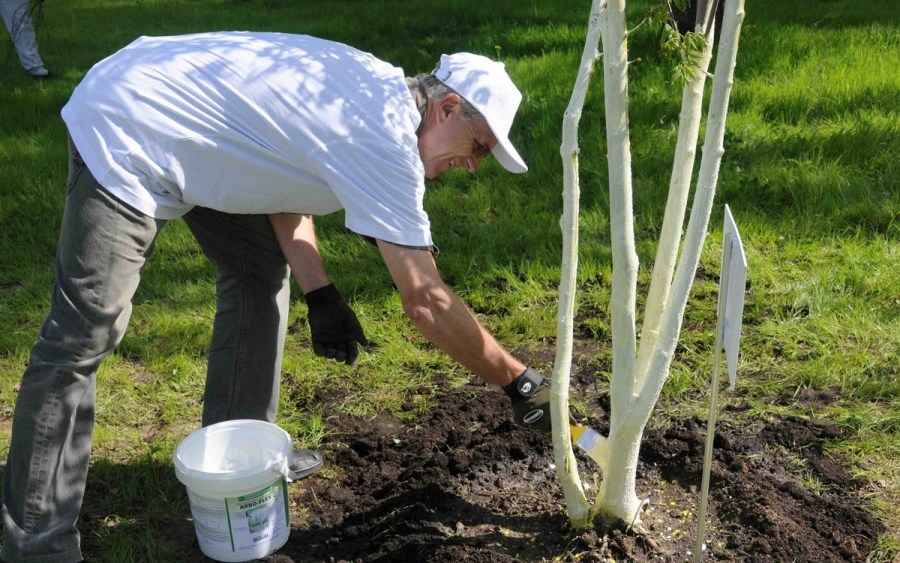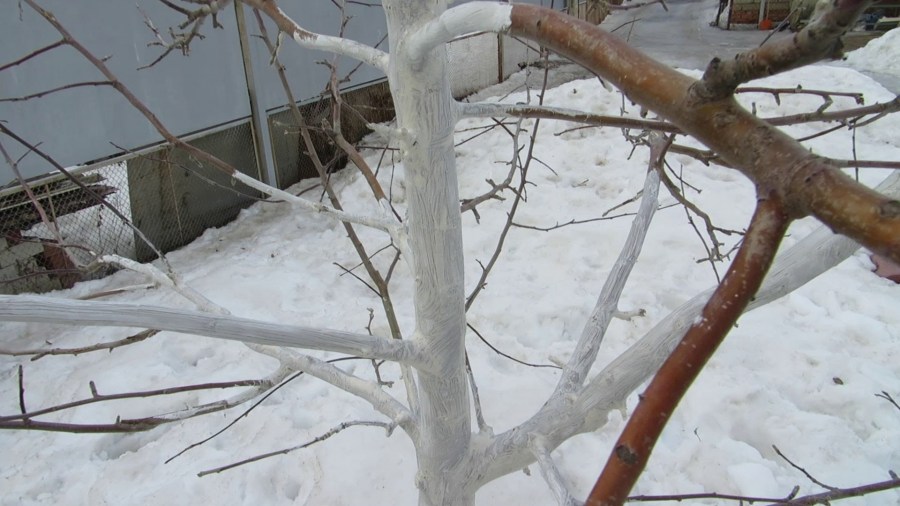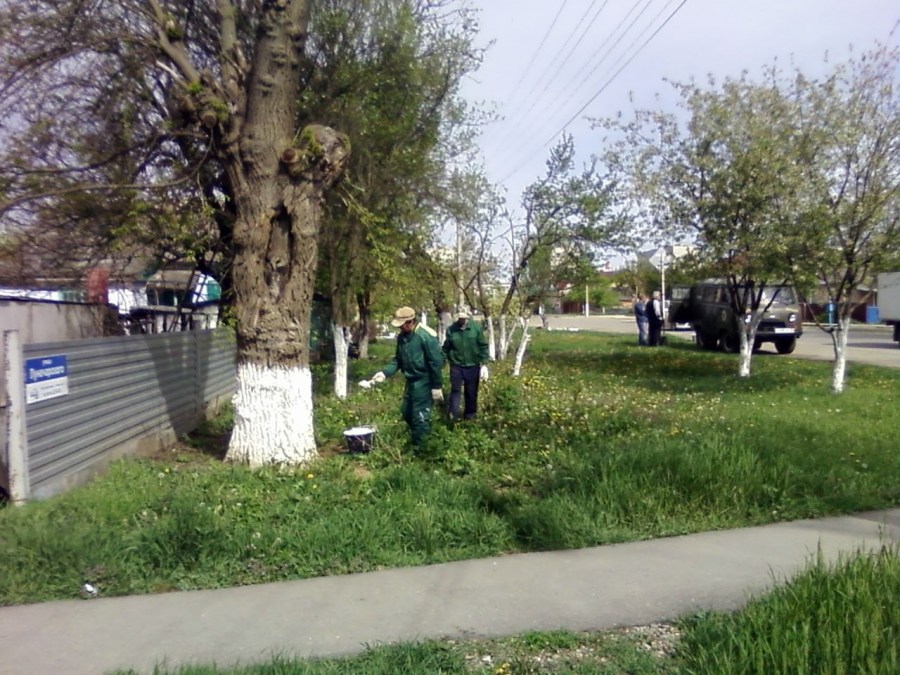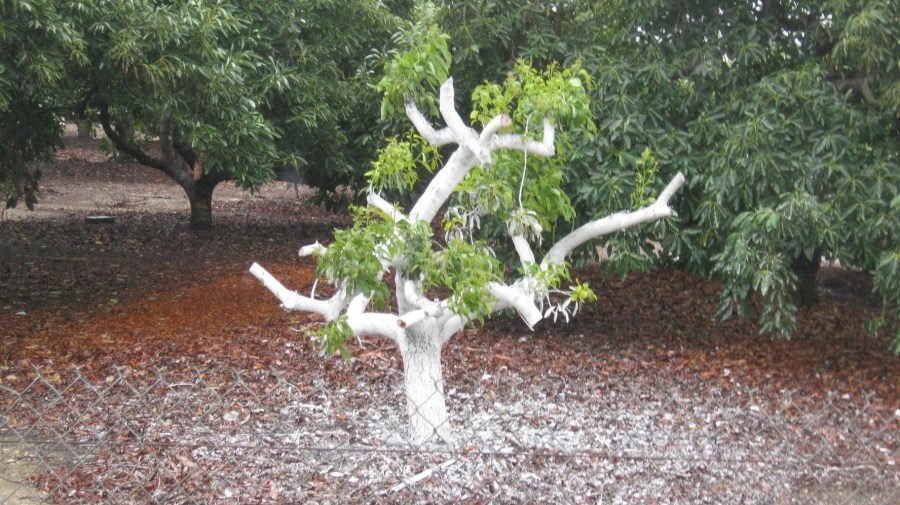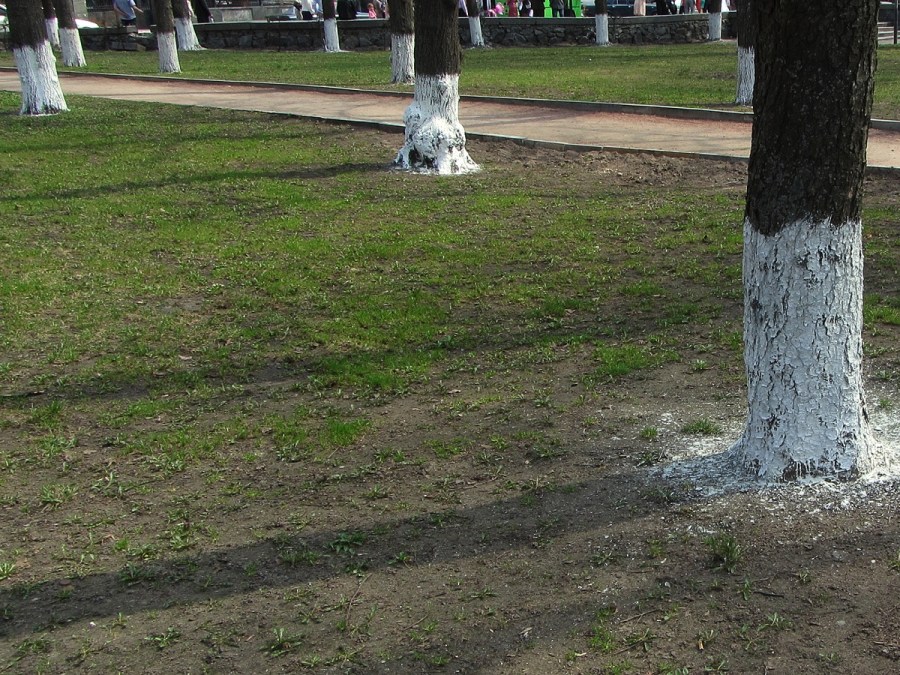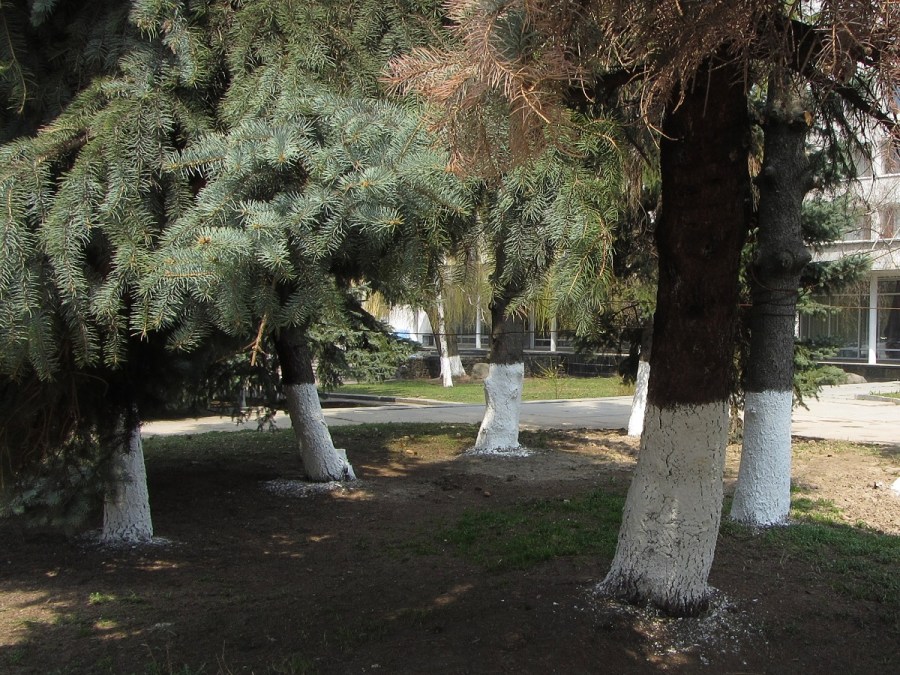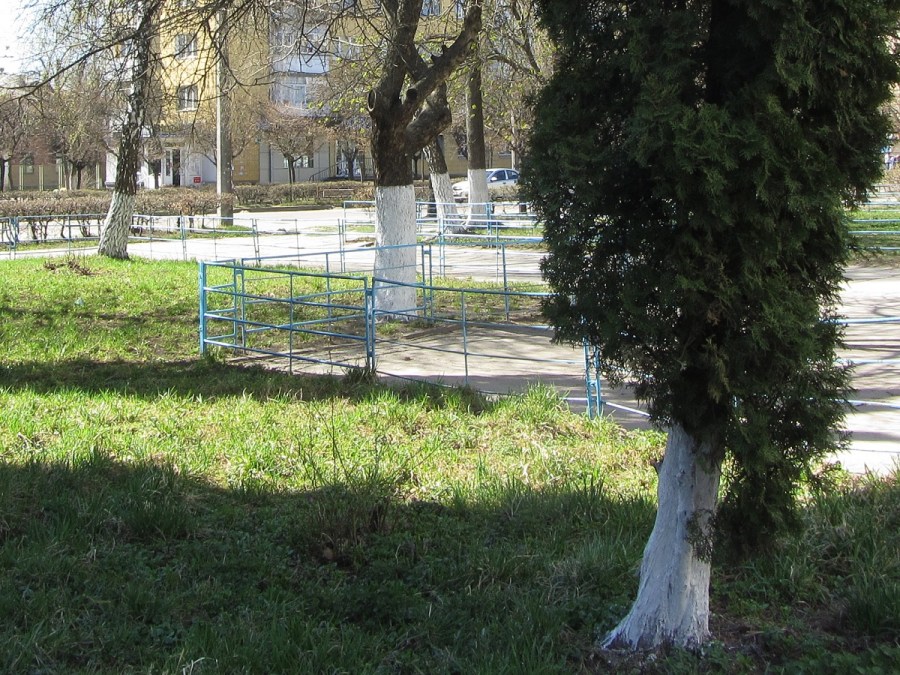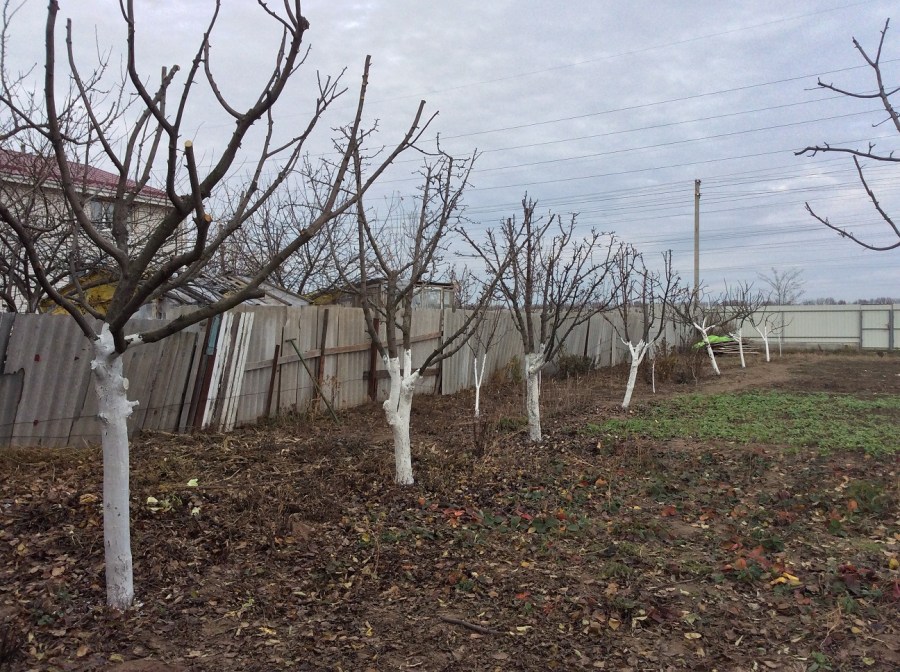Whitewashing of trees - when and how to whiten garden and decorative trees correctly (110 photos)
Many experienced gardeners know that for the preservation and development of fruit or decorative trees, their periodic whitewashing is required. It is important to choose the right time for the work and the used coloring material. And our article will help you answer the question of how to carry out these works with the greatest benefit for the garden.
Purpose of whitewashing of trees
The tradition of coating tree trunks with lime mortars arose a long time ago and remains popular at present. And there are several reasons for this:
- Protection from direct sunlight, which often leads to very severe burns on the bark of plants. And if you cover the trunk with a protective layer, then overheating and cracking can be prevented.
- Smoothing the effects of temperature changes. The protected tree will not overheat under the sun, icing and freezing of the wood surface will be excluded. Prevention of frost pits will not allow harmful spores to develop in the cortex.
- Pest protection. Lime and fungicides destroy insects and microorganisms, protect the bark from being eaten by animals.
Some inexperienced gardeners have heard that whitewashing garden trees can harm young seedlings. But it is not so.
If you take a high concentration of the solution, then the young bark can be harmed. It is more correct to soften the composition or purchase a special paint for plants and cover them with trees.
When whitewashing is done
Gardeners must timely perform work related to the processing of trees. If you stick to the schedule - 2 times a year, then you can protect plants as much as possible from the negative effects of external factors.
Autumn works
During this period of the year, it is important to comprehensively protect fruit trees such as apple, cherry, pear and plum. They are highly susceptible to the negative effects of temperature extremes. This is important because:
- pests die - ticks, aphids, leafworms, moths;
- the concentration of harmful bacteria decreases;
- trees are protected from the spring sun and unstable thaw.
At the same time, if you do the work early, the autumn rains will wash off the paint, and if you are late, frost will damage the trees. Therefore, the whitewashing of trees in autumn is carried out in October-November, before the onset of active frost.
Spring processing
Work can be done in March-April. The main thing is to choose a warm, dry day. During this period of time, the trunks often begin to warm up to 11 degrees, which causes the activation of sap flow. Lowering the temperature at night in this case is fraught with tissue damage and the appearance of frost pits. Spring whitewash:
- protects trees from early awakening, trunks from burns and night frosts;
- helps destroy pests.
It is important to calculate the dosage correctly and not harm the vegetation. It is not necessary to delay the treatment, so as not to miss the activation of insects.
In the course of work, the scaly bark is removed from the stem, and it is cleaned of larvae, lichen or moss. In the photo, whitewashing of trees you can see how to act correctly when applying solutions to the bark.
What materials to use
When carrying out protective measures in the garden, you need to prepare a fly-brush using an unnatural material. A flute brush will do. However, it is advisable to use them when processing small gardens.
And if there are a lot of trees, then you will need a spray gun. It is also necessary to stock up on special solutions. They can be prepared in many ways, but include three important components:
- pigment to give a white tint (chalk or lime, for example);
- adhesive composition;
- fungicidal substance.
Solution preparation at home
The easiest way to protect plants in the garden is to use lime for whitewashing or chalk solution. In this case, you can use several effective recipes:
Lime for whitewashing (slaked) or chalk in the amount of 3 kg is bred in 10 liters of water. Additionally, it is necessary to add 0.5 kg of copper sulfate to the solution, as well as casein glue (about 100 g) or 2-3 tablespoons of flour paste. All ingredients are mixed and infused for several hours.
The following components are mixed in 10 l of water - lime (2 kg), clay (1 kg), shovel of manure and copper sulfate (250 g). The solution can be used after 2-4 hours after preparation.
It is necessary to take 300 g of lime-fluff. Add vitriol (2 tablespoons) and a little glue to it - up to 200 g. The whole composition must be stirred in 2 liters of water. You should also add 200 g of clay and malathion in the amount of 25 g.
It is required to warm up 2 liters of water. Dissolve lime (2 kg), vitriol (400 g) and glue (100 g) in it. After that, mix everything and add 8 liters of water. Mix the solution thoroughly.
Despite the simplicity of preparing such a composition at home, it is not too durable and is easily washed off from trees. Therefore, the treatment must be carried out twice a year.
Acrylic and water based paints
Good protection of tree trunks can be achieved by coating them with acrylic paint. It has components that have an antifungal and bactericidal effect. Water-based paint is durable.
A dense protective layer will be created on the surface of the tree, which will not be washed off and will withstand the action of sunlight. But at the same time, the film will allow the tree to breathe freely.
The disadvantage is the inability to act on pests. Therefore, copper-containing substances are added to the composition.
The aqueous dispersion solution is distinguished by the presence of latex and an antiseptic in the composition. A breathable solution has been kept on the trunk for more than 2 years, protecting the plant from ultraviolet radiation. Wood should be treated with such paint at a temperature of at least 3 degrees.
How to whitewash
In spring, work is carried out with the beginning of warm days, but before the first leaves appear. But in the fall, you should not wait for the first frost. It is important to prepare tree trunks for processing. Correctly perform all the manipulations you will help our instruction on how to whiten trees.
Preparatory work
At the first stage, you need to thoroughly clean the bark. You should wait for damp, wet weather and carefully remove the crust, which is no longer viable, from the trunk and skeletal branches. Also, you need to remove the appeared moss and lichens.
Do not use tools that damage the plant. Act with your hands. A sliver or sharp peg will help treat cracks and inaccessible cavities. All material removed must be destroyed in the fire.
The bark must be treated with a disinfectant. You can buy ready-made compounds, for example, “Khom” ilm “Abiga-peak”. But for many in their strengths and for themselves it is easy to dilute the solution:
- dilute in 10 l of water 300 g of copper sulfate or 600 g of iron;
- heat 10 liters of liquid, dissolve there a 50 gram piece of laundry soap, as well as 3 kg of ash. Then the solution must be cooled.
The disinfectant can be applied with a brush or spray. The layer should be thin and not run down. It is important that it begins to settle on the surface and soak into it.
Tree processing technology
If you use a spray gun, then the material consumption will be slightly higher compared to the traditional method of applying the solution. So that the process goes much faster, you can pre-select brushes, the size of which would correspond to the thickness of the trunk and its branches.
To apply the composition of whitewashing for trees, you need to use a soft and fairly wide brush. It should easily penetrate the most inaccessible places. The solution covers the trunk to a height of 1.5-1.7 m providing a protective coating and lower skeletal branches.
The layer of applied whitewash should be about 2-3 mm. It should not be covered with an excessively thick cover, since it quickly crackes, and then sprinkles after complete drying.
It is recommended to rake the soil near the trunk, and then cover it with a solution below the ground. After drying, the soil returns to its place.
Sometimes the trunk coating dries to become gray. In this case, you need to use a brush and apply whitewash again until a white tint is obtained.
Timely processing of the trunk and the main skeletal branches will protect your garden from pests and the negative effects of natural factors. You are not required to implement extremely complex activities. Any beginner gardener can easily cope on their own.
Photo of the process of whitewashing trees
A nest of branches: a master class in manufacturing different weaving (60 photos)
Rope ladder - 60 photos of ideas for wells, trees and rescue options
Log houses (90 photos) - the best projects of 2019. DIY wooden house construction.
Form for tracks - 100 photos of design examples. Step-by-step instructions for creating a form
Join the discussion:
